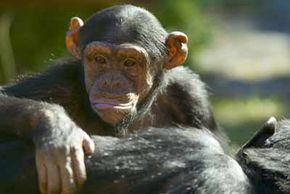If you were to put a sample of chimpanzee DNA next to a sample of human DNA -- and if you had any idea what you were looking at -- you would see that the samples are nearly identical. Chimps and humans share 96 percent of their DNA, and some new research suggests that chimps and humans may have split off from a common ancestor just 4 million years ago, which is a more recent estimate than the generally accepted timeframe of 5 to 7 million years. This would mean that it took about 4 million years for humans and chimpanzees to become completely separate species. The two are so close on the evolutionary ladder that observing chimps offers real glimpses into the way humans may have evolved. And a new, pretty major observation of chimp behavior may provide scientific evidence of a long-suspected theory about human evolution.
Chimpanzees are known to use tools. Many scientific studies, including Jane Goodall's famous work with chimpanzees in Gombe, Tanzania, have documented chimps using tools to complete or simplify tasks like cracking nuts open and getting termites out of logs. They've been observed using a stick to make an opening in a tree trunk big enough to where they get an arm in to pull out some bugs or honey or other delicacy. But not many researchers have been able to effectively observe chimps outside of Gombe -- it's hard to get them accustomed enough to human presence to catch them acting naturally for long periods of time. And until now, no one has documented a definite case of chimpanzees using tools to hunt in the traditional sense.
Advertisement
Jill Pruetz of Iowa State University and Paco Bertolani from the University of Cambridge successfully observed chimpanzees in Fongoli, Senegal, from March 2005 to July 2006. Their work, published online in the journal Current Biology on February 22, 2007, reveals documentation of chimpanzees using tools to kill animals for food. We'll take a look at the results of the study in the next section.



